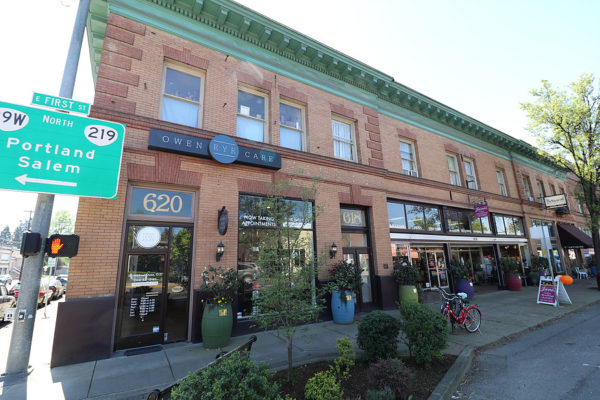
(Photo Courtesy of City of Newberg)
Newberg is following in the footsteps of towns like Astoria that recognize their historic buildings are economic assets as well as local cultural icons. The Newberg Graphic recently published this article discussing Newberg’s historic survey project to document their historic downtown buildings. A website was created to house findings of the survey, along with a mobile version of their downtown walking tour.
A closer glimpse of history
Written by Colin Staub, The Newberg Graphic
Learning about historic downtown Newberg just got a lot easier.
In 2015, the Newberg Historic Preservation Commission received money from the state to complete a historic survey project. The idea was to take stock of downtown Newberg’s inventory of historic buildings, as it’s been 30 years since the last survey was performed and some buildings might now be considered “historic” that weren’t before.
The project also examined future preservation opportunities and ended with the creation of a mobile device version of the downtown walking tour brochure.
A preservation expert visited the city and helped survey the downtown buildings, first compiling what’s known as a “reconnaissance level survey” of all the structures that could be considered historic, before narrowing in on some specific buildings as part of a more in-depth “intensive level survey.”
The survey looked at 112 buildings overall and was completed earlier this year. Now the results have been compiled into a new website to share the findings.
The website, www.historicdowntown newberg.com, is part of the “public education” goal of the survey project. It provides a digital method of accessing the walking tour brochure, a guide that takes visitors on a 12-point stroll around the downtown area.
Apart from the tour, the website also includes the entire list of historic resources that were looked at, the year they were built and whether they would be contributing or non-contributing structures should a historic district ever be established (essentially, are they architecturally significant).
No solid plans are in the works, but Rick Fieldhouse, chairman of the preservation commission, said the group is looking at the feasibility of establishing a historic district in the city: it would place some restrictions on what could be done to the exterior of contributing buildings, but would also open up funding options for projects like seismic retrofitting, and could have other local benefits.
“It’s pretty much a proven fact that historic preservation feeds tourism and tourism feeds money into the community,” Fieldhouse said.
The results of the in-depth survey of five particularly notable buildings are listed as well, including detailed architectural descriptions, explanations of the buildings’ significance, and numerous interior and exterior photos as well as historic images.
The in-depth survey’s goal was to determine which buildings could be eligible to potentially seek national historic designation, like the status of the Hoover-Minthorn house. The five chosen buildings are the Cameo Theater, Newberg City Hall, the Mills-Hester House (now the Painted Lady), the Carnegie Library portion of the Newberg Public Library, and the Morris, Miles & Co. building (now Chapters Books and Coffee). In the end the project showed that the Cameo Theater is a particularly feasible structure to possibly seek national designation.
Besides providing some data for future preservation efforts and simplifying the walking tour materials for tourists, Fieldhouse theorized the website could also help local residents learn about the history around them.
“Newberg in the past 30 years has grown so dramatically, we have a lot of people who aren’t third or fourth generation residents, more people who aren’t from a ‘Newberg family’ than are,” he said. “So it helps people get connected with the community and a sense of place.”
While this project has wrapped up, the plan is to treat it as an ongoing project and continue adding more to the survey as funding comes in. The preservation commission will receive some amount of grant money every two years.
“Right now the information is for the downtown core,” Fieldhouse said, “but in the future we can add on this information for other neighborhoods and it will be accessible in the same way.”
Visit the new website at www.historicdowntownnewberg.com.

